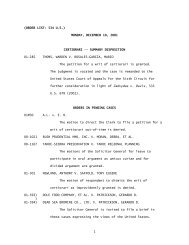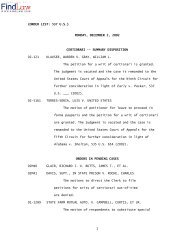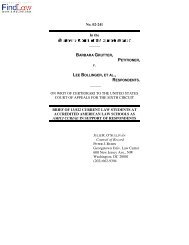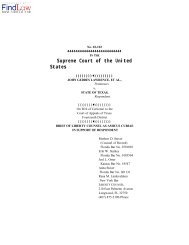No. 01-1757 Stogner v. California - FindLaw: Supreme Court Center
No. 01-1757 Stogner v. California - FindLaw: Supreme Court Center
No. 01-1757 Stogner v. California - FindLaw: Supreme Court Center
You also want an ePaper? Increase the reach of your titles
YUMPU automatically turns print PDFs into web optimized ePapers that Google loves.
28<br />
Id. at 532-33 (citation and footnote omitted). The <strong>Court</strong><br />
concluded that “[t]he relevant question is whether the law<br />
affects the quantum of evidence required to convict.” Id. at<br />
551. The answer was yes with respect to the Texas statute<br />
at issue in Carmell.<br />
When asked in relation to a law that changes the<br />
statute of limitations, the answer is no. A change in the<br />
statute of limitations does nothing to alter the State’s<br />
evidentiary burden to prove the commission of the charged<br />
offense; it simply regulates the time at which a crime<br />
defined and punished elsewhere may be charged. The<br />
State still must prove the defendant’s guilt by establishing<br />
all the elements of the charged crimes that it would have<br />
had to prove at the time they were alleged to have been<br />
committed, and it still must do so by proof beyond a<br />
reasonable doubt. See People v. Frazer, 21 Cal. 4th at 760.<br />
“The quantum and kind of proof required to establish<br />
guilt, and all questions which may be considered by the<br />
court and jury in determining guilt or innocence, remain<br />
the same.” Beazell v. Ohio, 269 U.S. at 170. Hence, this is<br />
not the type of law that impermissibly attempts to rectify<br />
a “deficiency of legal proof” in violation of the fourth<br />
Calder category. Wooddeson, at 633-34, quoted in Carmell,<br />
529 U.S. at 523-24 n.12. Indeed, it is for these same<br />
reasons that this also is not the type of law that violates<br />
the first Calder category, of which it is a “mirror image.”<br />
Carmell, 529 U.S. at 533.<br />
D. The Purposes of the Ex Post Facto Clause<br />
Are <strong>No</strong>t Implicated by a Retroactive<br />
Change in a Statute of Limitations<br />
As noted at the outset, the Ex Post Facto Clause<br />
serves to assure that legislative acts give fair warning of






